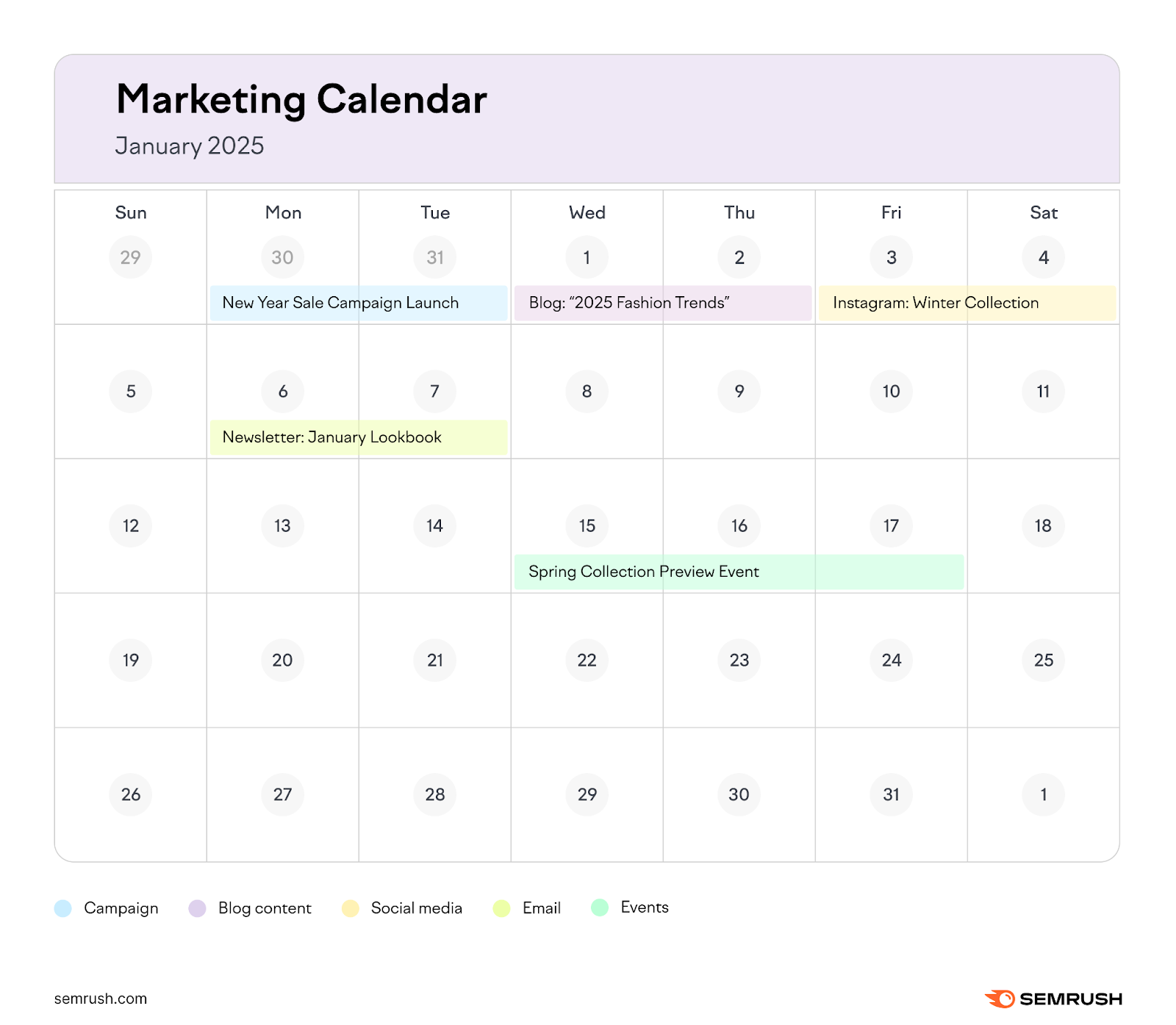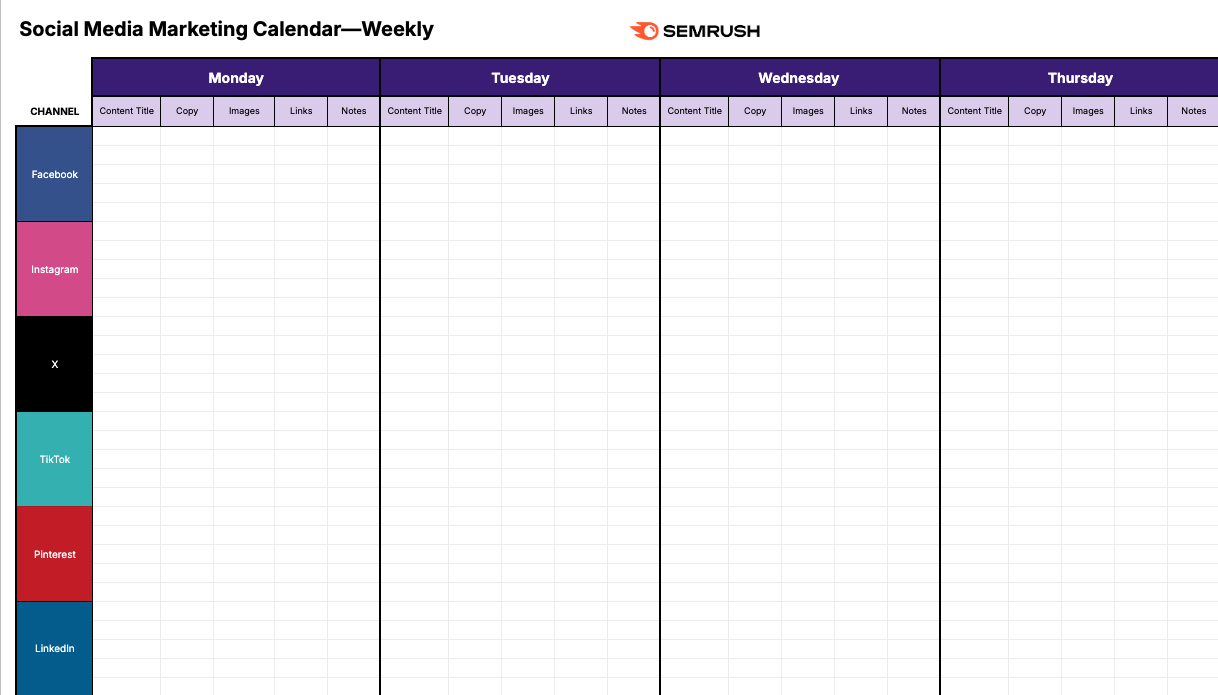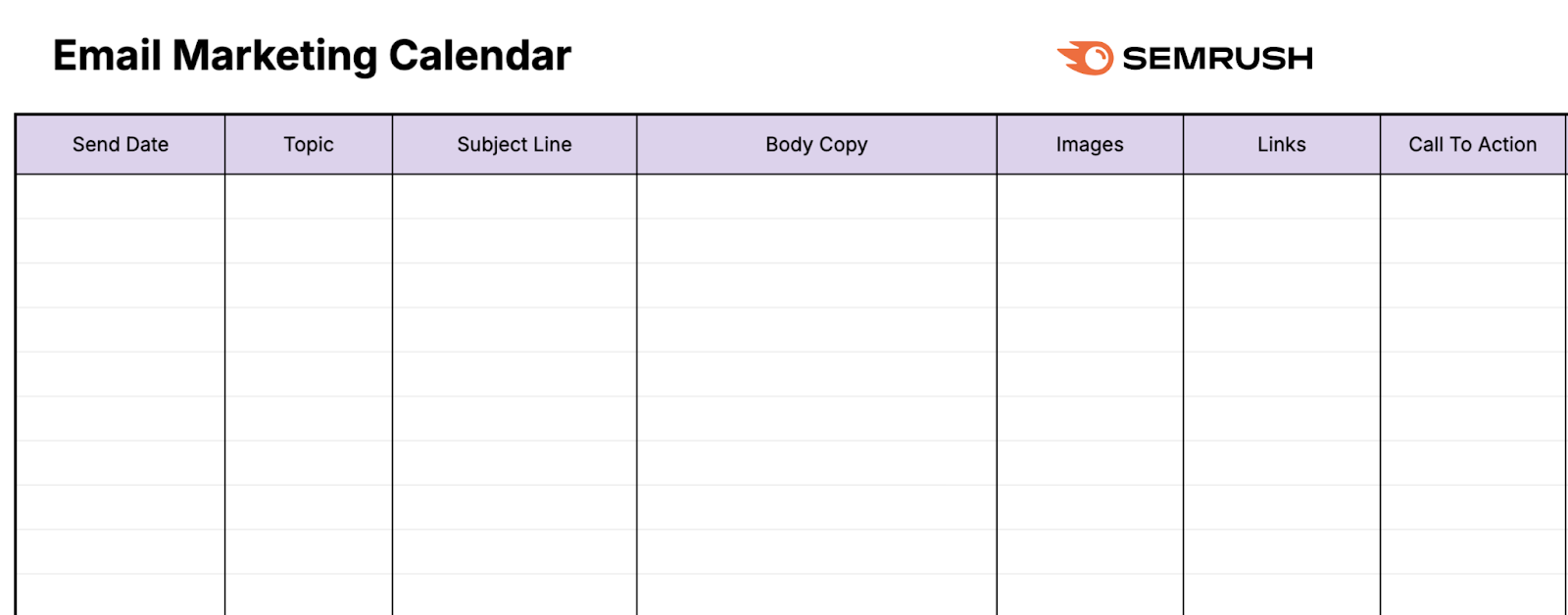A marketing calendar is a planning tool that helps marketers organize and schedule marketing activities, campaigns, and content to keep execution organized and consistent.
Here’s a marketing calendar example:

A well-designed marketing calendar keeps the whole team on track by clearly laying out each step of important marketing campaigns.
Marketing calendars also tell you who’s responsible for each marketing task. And when each task needs to be completed.
5 Marketing Calendar Templates for Different Marketing Channels
Different types of marketing calendars planning and execution for specific marketing efforts.
Here are five of the most common types of marketing calendars (including sample marketing calendar templates) to get you started.
Editorial Calendar
An editorial calendar (also known as a content calendar) maps out all the content you plan to create, the timelines, and the team members responsible for each piece.
This keeps your team on the same page and helps you publish content on time.
Use this editorial calendar template to coordinate and schedule your content.

This editorial calendar template has the following elements:
- Actual publish date
- Blog post (or draft) due date
- Blog topic
- Author
- Target keywords
- Target audience
- Offer or call to action (CTA)
Social Media Marketing Calendar
A well-organized social media calendar helps you maintain a consistent posting schedule and coordinate content across all your social media profiles.
It also gives you a clear overview of what you plan to post and when, so you can spot gaps in your schedule.
Use this social media marketing calendar template to organize content across all your social channels.

This social media calendar template includes:
- Which platforms you plan to publish content on (Instagram, LinkedIn, etc.)
- Posting dates
- Content titles
- Supporting copy
- Links to visual assets
- Additional notes
To further streamline social media scheduling, try Semrush’s Social Poster.
The tool’s interactive calendar lets you plan content for an entire year. And schedule posts across multiple platforms directly within the tool.

Email Marketing Calendar
An email marketing calendar helps you plan, schedule, and organize your email campaigns, such as newsletters, product releases, and promotional offers.
It also shows you how often and when you plan to send emails to your lists. So you know if you’re contacting your list too much or too little.
Use this email marketing calendar template to plan your campaigns in one organized view.

This email marketing calendar template includes the following:
- Your planned send dates
- The email topic
- The email’s subject line
- The email’s body copy
- Links to images
- CTAs
Marketing Campaign Calendar
A marketing campaign calendar maps out the activities related to your overall marketing plan, coordinating different channels and ensuring everything launches at the right time.
It helps you plan launches and prevent overloading your audience or team.
Keep your campaigns organized and track all your marketing campaigns with our free marketing campaign calendar template.

This marketing campaign calendar template includes spaces for:
- Your campaign’s start and end dates
- The specific marketing activity
- Your campaign name
- Who the team lead is for the campaign
- What channel(s) your campaign will run on
- Your marketing KPIs and goals
Holiday Marketing Calendar
A holiday marketing calendar includes key dates and seasonal events that matter to your business and audience, such as Black Friday, the back-to-school season, or your company anniversary.
This type of calendar is crucial for getting seasonal campaigns in order well in advance.
Use this holiday marketing calendar template to start planning.

This holiday calendar template includes spaces for:
- Holiday names and dates
- Campaign message
- Marketing channels
- Budget
How to Build Your Marketing Calendar from Scratch
Here’s how to build a marketing calendar that meets your needs and goals.
1. Choose a Tool to Build Your Marketing Calendar
Choose a tool to build your calendar based on your company’s needs.
For example, you can build your marketing calendar quickly and easily on Google Sheets for free. Especially if you use one of our templates.
But tools like Asana and ClickUp offer more advanced features like notifications, task tracking, and automated workflows.
When choosing a tool to use for your calendar, ask yourself the following:
- What is my budget?
- Is the tool easy to use and navigate?
- Will users get notified about calendar changes?
- Does it integrate with our other tools and platforms?
- Will it improve team communication and organization?
You may also decide to prioritize tools that have useful features, such as:
- Color coding to quickly spot different types of content
- Custom tags to group related items
- Multiple views (e.g., daily, weekly, and monthly)
- Status updates to track progress
- Filters to quickly find specific channels or campaigns
2. Select Your Primary Marketing Channels and Formats
Select your primary marketing channels and content formats to ensure you know how to customize your marketing calendar.
For example, if you want to focus heavily on social media, then create a social media calendar instead of an overarching marketing campaign calendar.
Some channels and formats you might incorporate include:
- Your blog
- Your social media profiles
- Paid social media and search ads
- Events and webinars
3. Build Your Calendar’s Basic Structure and Add Tasks
The next step is to include essential elements for tracking and organizing your marketing activities.
Start with the following elements:
- Campaign schedules: When each marketing activity starts and ends
- Tasks and ownership: Who's doing what
- Marketing channels: Where the marketing activity is taking place
- Key dates: Important events like launches, promotions, and holidays
- Resources: How much budget and what assets you need for each campaign
You can add more elements later based on your specific needs.
Next, make sure every campaign is broken down into every related task that’s needed for completion. Including reviews and approvals.
For example, here is a potential timeline for creating a blog post:
- Three days for the writer to research, plan, and write
- Two days for editorial review
- One day for revisions from the writer
- One day for image creation
- One day for final review
Your timelines will vary based on content type and team size, but having standards like this helps keep projects moving smoothly.
4. Assign Ownership
Every task on your marketing calendar needs a clear owner who will complete their portion and pass the project to the next phase.
For example, in the process of creating a blog post, assign a clear owner for the following tasks:
- Writing the blog post
- Editing the content
- Handling revisions
- Creating the images
- Conducting a final review
- Publishing the content
5. Keep Your Marketing Calendar Updated
Keep your marketing calendar updated to ensure it serves as the source of truth for all marketing efforts.
To do that, request that team members mark tasks complete as soon as they’re finished.
This is an example of a workflow for keeping your calendar up-to-date:
- Writers send completed drafts to the editing team by sharing a document link in the calendar and notifying the editors
- Editors send edited drafts back to the writers by checking a box in the calendar and notifying writers
- Writers apply revisions, share a new link (if needed), and notify the final reviewers
- Final reviewers send the drafts to the publishing queue by checking a box in the calendar and notifying the publisher
- The publisher pushes the content live and marks it as published in the calendar
This workflow keeps everyone on the same page and informed about the status of every project.
This transparency helps teams spot bottlenecks quickly and adjust timelines if needed.
Streamline Marketing Activities with an Organized Calendar
A marketing calendar helps you execute your strategy more effectively and reduces the odds of making mistakes.
So, download one of the free templates above. And make sure you have the tools you need to execute every project.
For example, SEO tools that can help you gain visibility in search results.
A free Semrush trial gives you lots of options, including the Keyword Magic Tool (to find terms your audience enters in Google) and Position Tracking (to see where your content appears in search results)/
